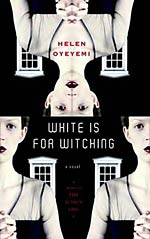
![]() Rhondak101
Rhondak101
10/16/2014
![]()
Helen Oyeyemi has been touted as a wünderkind because she published her first novel The Icarus Girl (2005), when she was still a high school student. While studying at Cambridge, two of her plays were performed and later published by a major publishing house. White is for Witching (2009) is Helen Oyeyemi's third book and the first book by her that I've read. It was a finalist for the 2009 Shirley Jackson Award and won the 2010 Somerset Maugham Award.
This book is clever and compelling. I have read several negative reviews of it. I understand why the reviewers had the problems that they did. A reader's personal taste concerning narrative style and tolerance for the abnormal will certainly influence his or her experience of this book. While this can be said of any book, a plot-driven book told in chronological order with a standard first or third-person narration rarely raises hackles the way that more experimental forms, like White is for Witching do. It is much the same way with food. Do you like pineapple on your pizza? Do you salt your watermelon? Do you mix potato chips and ice cream? (yes, no, sometimes)
Two factors, then, can strongly influence a reader's experience. The book is very British (content, politics, humor, or should I say humour). And the book is very post-modern in its narrative style, its organization and its lack of character development. It is fragmented; it is episodic. It is NOT more than the sum of its parts. Fortunately, I am an Anglophile who loves post-modern novels. Therefore, my head can understand why people would not like this book, but my heart is more biased.
So, while I don't think of Miranda, Eliot or Ore as even vague approximations of real people, I find the way Oyeyemi constructs the relationship between Miranda and her twin brother compelling; I appreciate the words that she gives Miranda as a flawed, bizarrely charming, teen-aged intellectual; and I am intrigued by the strange bond that Miranda and Ore form. I am fascinated by the narration that the house itself provides. The house offers an interesting look into xenophobic and obsessive compulsive behaviors. The house is equally destructive to those it loves and those it hates but in very different ways.
In addition to the sentient, Gothic house, Oyeyemi brings in elements of Afro-Caribbean folklore and Western fairy tales. The Snow White references are prominent in relation to Miranda and the house. Other characters (often immigrants) bring their own beliefs, such as Caribbean soucouyants (old women who shape shift to consume the souls of others). The Yoruba cook/housekeeper, Sade, brews up potions and puts up talismans all over the house.
While fun (at least for me) and smart and appealing, the book is not perfect. The ending is messy for several different reasons. The ending is ambiguous but clearly unhappy. None of these characters are going to live "happily ever after." Plus, many questions the book raises are left unanswered: Was Eliot in South Africa? Why does Sade keep going to the Immigration Removal Center? Does the house manifest itself as Miranda and wander around the town of Dover? Did this manifestation of Miranda attack Tijana's cousin? As a reader, I wanted complete closure and answers to all of these questions and more but I didn't need them. Despite its problems, I was fascinated and intrigued by the book. I felt compelled to keep reading and stayed up late too many nights because of it.